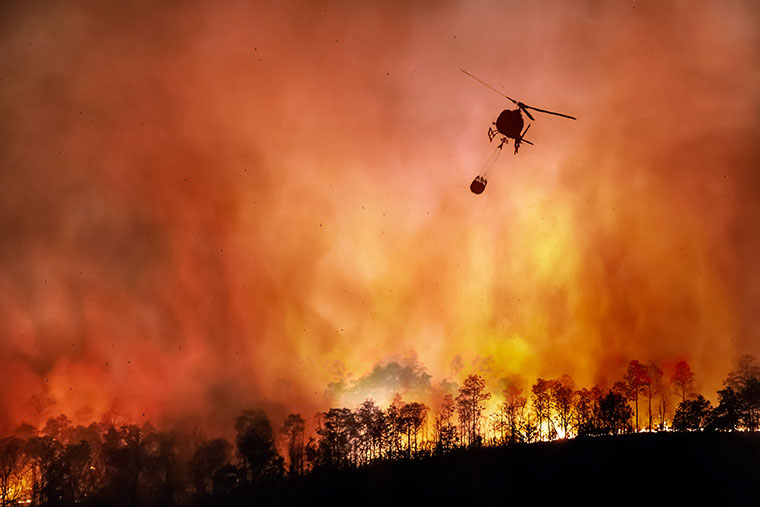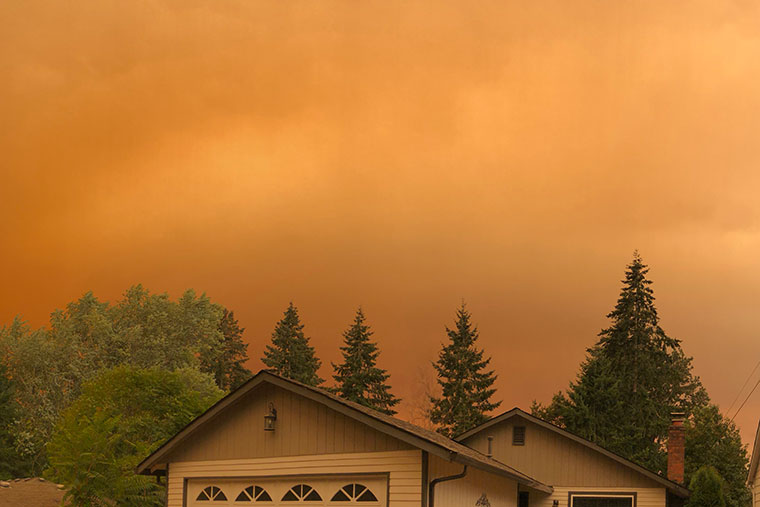In advance of a wildfire season projected to be among the worst, an American Thoracic Society (ATS) report calls for a unified federal response to wildfires with several components:
- Investment in research on smoke exposure and forecasting.
- Investment in research on health impacts of smoke.
- Evaluation of interventions.
- Clear and coordinated communication strategy to protect public health.
The report, Respiratory Impacts of Wildland Fire Smoke: Future Challenges and Policy Opportunities, was published online May 3 in the Annals of the American Thoracic Society. It is the outcome of a 2019 workshop with a multidisciplinary group of 19 experts, including pediatric and adult pulmonologists, toxicologists, epidemiologists, public health officials, and wildland fire managers.
 Both firefighters and people who live and work near fire outbreaks may inhale complex mixtures of chemicals and particulates. (Photo courtesy of Toa55 / Shutterstock.com)
Both firefighters and people who live and work near fire outbreaks may inhale complex mixtures of chemicals and particulates. (Photo courtesy of Toa55 / Shutterstock.com)Worsening severity
The report comes at a time when the U.S. is experiencing an increasing frequency of very large destructive wildfires, due to years of fire suppression, population expansion, and a lengthening fire season due to climate change.
- The 2018 Camp fire in California is believed to be the deadliest in the state’s history.
- Parts of the Midwest have also experienced record-breaking fire devastation.
- Inhaling wildfire smoke can have serious health consequences, particularly for children, older adults, and those with lung diseases such as asthma and chronic obstructive pulmonary disease (COPD).
- Less appreciated is that smoke plumes can travel hundreds and even thousands of miles, affecting regions where there may not even be awareness of the smoke and its air quality impact.
 Before stepping up to serve as acting deputy director, Collman directed the institute’s Division of Extramural Research and Training. (Photo courtesy of Gwen Collman)
Before stepping up to serve as acting deputy director, Collman directed the institute’s Division of Extramural Research and Training. (Photo courtesy of Gwen Collman)NIEHS Acting Deputy Director Gwen Collman, Ph.D., participated in the 2019 workshop and is a co-author of the report.
“Given the increase in frequency, intensity, and duration of wildland fires that many parts of our country are experiencing, it is critical to take a multidisciplinary research approach to understand the components of fire science, potential for human exposure near the fire site and afar, and health impacts in order to protect the most vulnerable populations,” she said.
“This workshop brought fire scientists together with state and local experts in public and clinical health to discuss tools and approaches that may lead to predictions for future fire seasons that could help to reduce impacts,” Collman added.
The report highlighted the need for more research, specifically “on the effects of long-term and repeated wildland fire smoke pollution on respiratory, cardiovascular, neurological, and psychological health across life-stages, including developing fetuses and children,” as well as firefighters.
Complex exposure
“Wildland fires release complex mixtures of particles and gases into the air that, when inhaled, can harm the lungs and cardiovascular system in a number of ways,” said lead author Mary Rice, M.D., a pulmonologist at Harvard University. “We see the health effects of wildfire pollution in terms of more frequent asthma symptoms, emergency visits and hospitalization for asthma and COPD, and higher mortality during smoke events.”
Children, whose lungs are still developing, and adults with lung disease are among those at highest risk, especially in areas that experience fires year after year. Firefighters are repeatedly exposed to high levels of smoke, often with little respiratory protection. Little is known about the long-term consequences of repeated smoke exposure, the report emphasized, or potential benefits of interventions to lessen health effects.
 In September 2020, smoke blanketed a Portland, Oregon neighborhood, suggesting exposures that even people far from a wildfire may experience. (Photo courtesy of Kelly Lenox)
In September 2020, smoke blanketed a Portland, Oregon neighborhood, suggesting exposures that even people far from a wildfire may experience. (Photo courtesy of Kelly Lenox)
Broad involvement needed
The report’s authors maintained that a coordinated approach across agencies is essential to assessing the health risk of wildland fires and, ultimately, developing strategies to manage that risk.
“Air pollution resulting from wildfires crosses borders and economic lines,” said co-author Dan Costa, Sc.D., from the University of North Carolina at Chapel Hill. “Therefore, dedicated research funding and ongoing support from the federal government is needed to fill knowledge gaps, including developing models for fire management as well as assessing toxicity levels and interventions.”
Despite the public health impact, the authors found that the public’s and even many physicians’ appreciation of the health risks and consequences of wildfire smoke exposure was lacking. “The air quality problem of wildfire smoke is only going to get worse,” said Rice. “The medical community is in need of evidence-based guidance to protect patients and their families from the harms of smoke inhalation.”
Citation: Rice MB, Henderson SB, Lambert AA, Cromar KR, Hall JA, Cascio WE, Smith PG, Marsh BJ, Coefield S, Balmes JR, Kamal A, Gilmour MI, Carlsten C, Navarro KM, Collman GW, Rappold A, Miller MD, Stone SL, Costa DL; on behalf of the American Thoracic Society Environmental Health Policy Committee and the American Thoracic Society Assembly on Environmental, Occupational, and Population Health. 2021. Respiratory impacts of wildland fire smoke: future challenges and policy opportunities. Ann Am Thorac Soc; doi: 10.1513/AnnalsATS.202102-148ST [Online 3 May 2021].
(This article is from a May 3 press release by the American Thoracic Society.)









